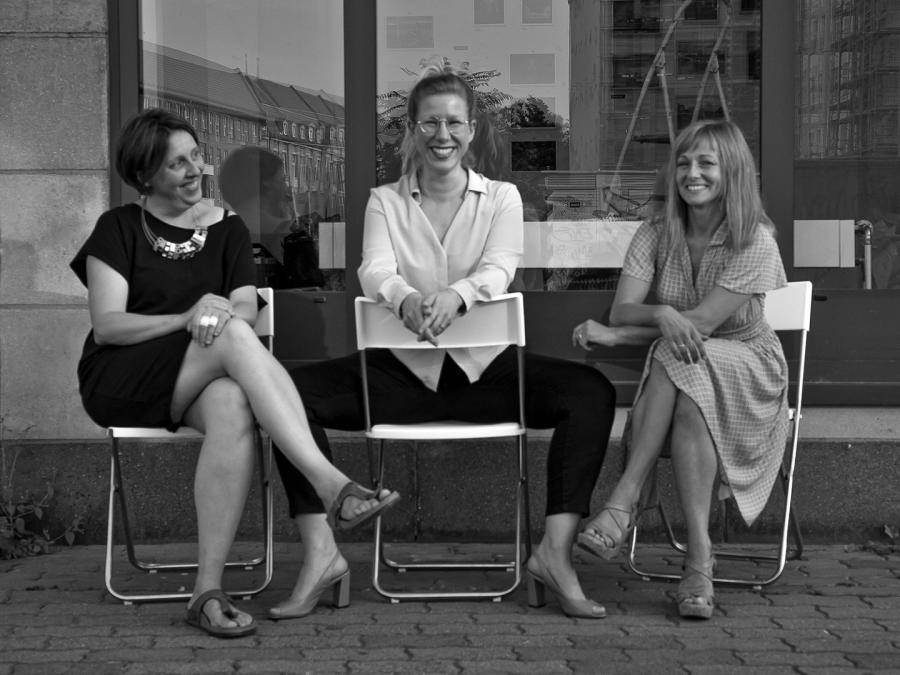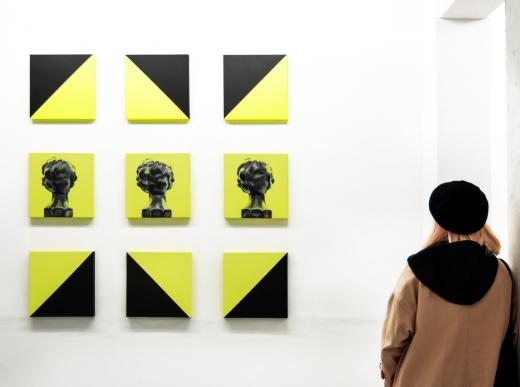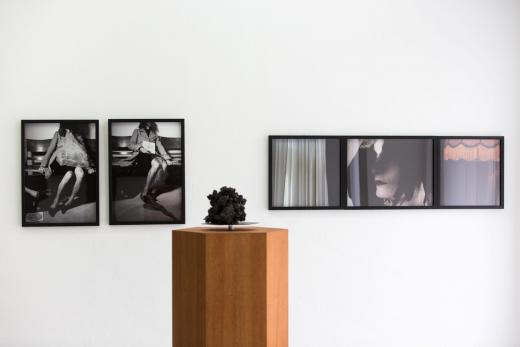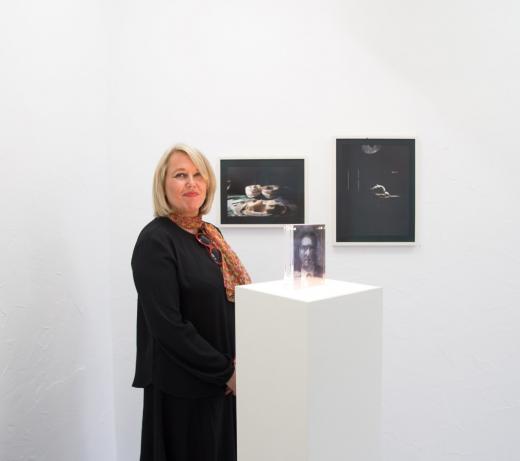Have you met... BERLIN BLUE art
Have you met... BERLIN BLUE art

Making friends with BERLIN BLUE art was a no-brainer for the Bpigs team – a young contemporary gallery run by three female artists/curators supporting fellow female artists is the kind of story we are always eager to hear. This new gallery represents emerging and mid-career artists in their space in Berlin-Mitte, while stimulating dialogue, discourse, creative connections, and exhibition projects. We spoke with the three founders – Kama Jackowska, Renata Kudlacek & Nele Ouwens – to find out what makes this gallery special.
Let's start off with the name. Why BERLIN BLUE art?
Nele: BERLIN BLUE is the original, old name for the color that is nowadays better known as Prussian Blue. It is a very dark Blue, shifting towards Black, the color of a night sky. It was also the first synthetically developed pigment, the first modern pigment so to speak. It is the color that is used for blueprints and it plays an important role in medicine as an antidote for poisonings. All of our surnames are really not so easy to remember – so we looked for something else, and BERLIN BLUE had enough interesting connotations, the right "aura".
Renata: … and the name has simply two important connections – the city we are based in and art (reflected in an artist color). There is a story of “Berlin Blue the color” and its invention in 1700 when they managed to keep the production method as a secret for 20 years. It took the inventor in Berlin (a theologian, alchemist, and physician) 300 experiments to develop a color explicitly to be useful for artists only. I like this very much…
Kama: And you can even go beyond the specific color “Berlin Blue” and just think about the color Blue and its variety of associations for a moment. It represents the sky and water, and with it openness and depth.
Could you tell us something about yourself and your background?
Nele: My background is an academic one, I studied art history, theater, and politics. Therefore I developed a critical and analytic view towards exhibitions and plays. I have also worked as a freelancer for newspapers and in communications for years, which equipped me in the field of writing. I was born and raised in the western part of Germany, the Ruhr area in particular and have lived in Bremen before I came to Berlin in 2011 with the goal to meet like-minded people and develop artistically in an inspiring environment. I think it is very important to mention that all of us are artists ourselves. I am a painter, my motives shift between realism, magic realism, and surrealism. I create motives using very different sources like dreams, family history, or impulses from culture and art. My subjects include vast landscapes, human figures, and objects. Many of my works allow for identification and speculation at the same time, and contain notions of the sublime, of solitude and contemplation, and of quirkiness and mystery.
Kama: I am an artist and graphic designer, originally from Poland, from Warsaw. But I am a typical East European mix, my family roots are leading to Czech Republic and Russia as well. It all had a huge impact on my artwork. I am constantly exploring modern history, especially period of the World War II and Holocaust. I am trying to explore the material and nonmaterial remains of the war. I am curious how they still function in a city landscape. In my latest works I transfer my considerations to a more contemporary and universal sphere of closed territories, delimited by visible or invisible walls as a comment to actual political situation. I specialise in screen-printing, but my works are unique, experimental works, that might be placed somewhere between painting and printmaking. In my artwork I am trying to combine my art experience (I was studying in graphic department at Warsaw Academy of Fine Arts) with my archeological knowledge (I was also studying archaeology at Warsaw University). But almost six years ago I decided that making art in Poland is too big of a challenge, and instead of fighting reality it would be easier to come here to Berlin to explore the opportunities and infrastructure the city offers.
Renata: Originally I am from Czech Republic, growing up and living in different parts of Germany until I went to London to study fine art. As an artist I work in different media, whilst specializing in fine art photography and print. Much of my recent work relates to the centuries old discussion, which raises the question of life and its origin. With this I am also part of the Arts & Ethics Research group at the Edinburgh University. Already during my BA I had a great interest in curation and running projects with other artists. After graduating from the Royal College of Art I started actively working for various art and education initiatives including project management and curation. This included many international shows and art screenings. When I moved to Berlin 5 years ago it was clear that I would continue as an artist and a curator, keeping the international connection alive. My wish was also to bring more of London to Berlin.
How did you three meet, and what led you to open this space together?
Nele: Renata and I met because I was looking for a studio partner. We got along very well right from the start and, after sharing a studio for a year or so, we decided to look for a gallery space. We have both organised shows before and our first collaboration as curators was a traveling show with international artists in 2015. We took this show to Tuscany and London. Luckily we found our gallery space around the same time, and so we could set up this exhibition as one of our first in our own space in Berlin.
Renata: I met Kama at the Druckwerkstatt (print studio) in Kulturwerk Bethanien, a great space for artists in Kreuzberg. We connected very quickly and shared ideas. Once the tree of us went out for drinks the story began…

"URBAN HI(S)STORY" by Silvia Binda Heiserova @ BERLIN BLUE art
What are some of the topics you intend to tackle through the gallery's program?
Nele: This year’s program in particular consists of critical and analytical positions. In spring we showed two artists who analyse the construction of history and roles in society (Silvia Binda Heiserova, Stine Nielsen Ljungdalh), in summer we had an international group show exploring the reciprocal influence of arts and ethics (Arts & Ethics Research Group), and now for fall we will look deeper into the experiences of patients and doctors in the medical sector with artist Emma Barnard, and into the possibilities of representations of the human body with Agata Czeremuszkin-Chrut & Marina Roca Die.

"SILVER" by Stine Nielsen Ljungdalh @ BERLIN BLUE art
Tell us about your curatorial strategy. How do you organise the shows and choose your collaborators?
Renata: On many occasions collaborations and project just fall into places. It kind of has to be organic and feel natural to me. I am still very well connected with many artists and curators I met over the years. Having an ongoing exchange, ideas come alive and collaborations happen. Everytime I have an idea for a show it is because I have an artist already in mind. They are my curational inspirations. Like the Arts & Ethics research group show "Field Works" which I co-curated this year. It all started with a few artists and ideas, and developed into an international group show of artists collaborating with academics and scientists. I am also excited by the use of mixed media in shows like this one, consisting of visual, video, sonic, written, and interactive works that are meant to both challenge and inform, probe and provoke.
Kama: My goal as a curator is to show more mid-career, Polish artists to Berlin audience. This generation of artists is barely seen here in galleries, which makes a gap I want to fill. I still have a great connection with some Polish artists and curators, and it would be stupid not to explore it. We have already organised a few Polish exhibitions showing variety of works. Just to mention that we had a pleasure to host a show “Body Language” curated by Bartlomiej Jarmolinski, presenting variety of works in different media exploring subject of body. I was also curating two artist shows of Maria Piątek and Magda Fokt, and recently show of Jakub Łączny and Agnieszka Zawisza.
Nele: There are many ways that can lead to a collaboration. We are working with artists whom we already knew and have wanted to work with from the beginning. Then there are relationships that have grown throughout the last two years since we opened the gallery in 2015. And of course we are on a constant quest for great works! As a curator I am interested in a clear, strong, persuasive style, in works that come from deep thinking, (re-)searching minds, and that therefore tend to tackle your brain. I am interested in all media and a broad range of styles. For me it is really about the impact a piece has.

"FIELD WORKS" by Arts and Ethics Research Group @ BERLIN BLUE art
As an all-female team running a mainly female-centric gallery – what can you tell us about the representation of women currently in the local art scene? What are your experiences as artists and curators?
Nele: Well, there is an all-female cast of nominees for the Preis der Nationalgalerie 2017, that's great! And there are influential female galerists like Esther Schipper as a role model. It is actually more a coincidence than a programmatic decision that we are mainly working with women, to be honest. We choose positions and interesting topics, not gender. As for the representation of female artists in Berlin, it is my feeling that they are doing pretty good. Berlin is a very rapidly changing city with not so many old-boy networks in place, and young creatives move to this city on a constant basis. But – and that's just an educated guess, I haven't evaluated it for Berlin in particular – I am pretty sure that nevertheless female artists are still underrepresented when it comes to prestigious solo shows. As they are on a broader international scale in terms of representation on fairs or auction sales.
Renata: Yes, I can only agree. And again this is something that happened naturally. After graduation I co-curated with another artist (Emma Barnard – actually one of our artist and upcoming shows ) an international all-female show in London. It was something very important for my career as an artist and curator in many ways. Conceptionally we wanted a snapshot of contemporary female visual language in direct respond to the surrounding at the Docklands London, set against cooperate imposing towers, the city skyline, and a largely male dominated area. Since then I have a keen interest in female artists, and so I know more female than male artists. However, I have to add – the artist's work is what counts first and foremost, not the gender.
Kama: I can only agree with Nele and Renata. And the only one thing I want to add is that around 80% of all artists I personally know are… women. The representation of women in the art world is getting bigger and stronger, so it is kind of a natural thing that new galleries like BERLIN BLUE art are responding to it.
What is currently on display at BERLIN BLUE art?
Renata: Our current exhibition (Opening on September 15th 2017 for Berlin Art Week), "Primum Non Nocere", is by UK-based artist Emma Barnard. Her art is developed through collaborations with consultant surgeons and their patients and it reflects on the harsh realities people endure in their pursuit of "getting better". It provides insights into the surgeon and patient dynamic and expands on the air of mystery surrounding the surgeon's practice, the immense pressure that they are under, and the harm that this may cause them. Emma Barnard works in lens-based media, interdisciplinary practice and research within Fine Art and Medicine. Her show includes thought-provoking materials and theories of "projection" e.g. the patient viewing the surgeon as a miracle worker. Part of the work is based on the philosopher Michel Foucault’s notion of the "medical gaze" that denotes the dehumanizing medical separation of the patient's body from the patient's person. Staged photographic and moving image tableaus will form a dialogue, including artifacts such as biomedical and patient notes and surgical theatre drawings.

Emma Barnard and her works @ BERLIN BLUE art
What is coming next?
Kama: “The body is in the eye” will feature Agata Czeremuszkin-Chrut and Marina Roca Die, two painters from Poland and Spain. The show will open on November 3rd 2017, and it presents both very classic and also very modern paintings. Two artists with two very different experiences and backgrounds are exploring one of the oldest subject in art – the human body. Agata Czeremuszkin-Chrut has a very biological approach to human body. Her work is based in biological processes, in the carnality defining all living organisms. Her artwork reflects materiality. On the opposite, Marina Roca Die works with a more psychological approach. Her works tackle the body/mind dualism and refer to representations employed from diverse branches, for example philosophy, psychology, and cultural history.
How would you like to see your gallery developing in the coming years? Do you have some long-term plans you'd like to share with us?
Renata: International exchange and collaborations – exploring ideas… also a mix of male / female shows – surprises…
Nele: We already have a few exhibition projects in mind, but as these are not completely finalised with the artists yet, it is too early to talk about them. One project that we can talk about is an exhibition that will feature promising upcoming artists following the process of an open call. We want to do this on a yearly basis starting from 2018. As a gallery we want to foster emerging talents and this project is going to be a great chance for artists to become more visible and for our audience to discover their positions.
Kama: Yes and, of course, we hope to see all the readers of Bpigs in our gallery in the coming years! But you are of course allowed to already visit us this year… (laughs) At the end of the year (opening on November 30th 2017) we will have a group show with all of our artists – a great opportunity to meet all of them and get to know their works.
* * * * *
Köpenicker Str. 96, 10179 Berlin
www.berlinblueart.com
Coming up:
Emma Barnard – "Primum Non Nocere"
16.09. – 07.10. 2017
Opening: 15.09 / 18 – 21h
More info